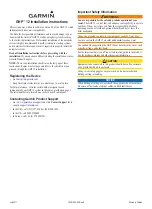
p70 & p70r and Evolution autopilot —
overview
This document will guide you through the steps required in
setting-up and commissioning your Evolution autopilot system
using a Raymarine p70 / p70r autopilot control head.
If you are an existing user of Raymarine autopilot systems
,
this document will also help you to understand the differences
between the commissioning process for existing SPX autopilot
systems, and the Evolution autopilot system. For example, there
are a number of existing set-up and commissioning steps that
you might already be familiar with for SPX systems, which are
no longer required or are slightly different for Evolution autopilot
systems.
Evolution autopilot installation
For information on installing and connecting an Evolution
autopilot system, refer to the installation instructions that
accompany the EV-1 and EV-2 units, as appropriate.
Evolution autopilot operation with p70
& p70r
General operation of the p70 / p70r is the same for Evolution
autopilot systems as it is with existing SPX autopilot systems.
Refer to document number 81331 for p70 / p70r operation
instructions. This document is supplied with all p70 / p70r units.
It is also available to download from the Raymarine website:
www.raymarine.com
.
Autopilot commissioning — main
differences between Evolution and
SPX systems
The Evolution system provides a number of features to improve
upon the commissioning process required by existing SPX and
some other autopilot systems.
•
Built-in heading and attitude sensor
— no additional
fluxgate compass required.
•
Automatic set-up
— the rudder gain, counter rudder, manual
compass calibration and autolearn settings required for
existing SPX systems are no longer required. This results in
a greatly simplified dockside calibration process for Evolution
autopilot systems.
Autopilot response levels
The Evolution autopilot system features a number of different
response levels to help you quickly configure the system for
optimum performance for the current conditions.
The available response levels are:
•
Leisure
— suitable for long passages where tight heading
control is not critical.
•
Cruising
— good course-keeping without overworking the
pilot.
•
Performance
— emphasis on tight heading control.
You can change the response level at any time by selecting
MENU > Response Level
. Then select
Save
to keep the
changes.
Initial setup and commissioning
Commissioning pre-requisites
Before commissioning your system for the first time, check that
the following processes have been carried out correctly:
• Autopilot system installation completed in accordance with
the Installation Guide.
• SeaTalk
ng
network installed in accordance with the SeaTalk
ng
Reference Manual.
• Where fitted, GPS installation and connections has been
carried out in accordance with the GPS installation guide.
Check also that the commissioning engineer is familiar with the
installation and components of the autopilot system including:
• Vessel type.
• Vessel steering system information.
• What the autopilot will be used for.
• System layout: components and connections (you should
have a schematic of the vessel’s autopilot system).
Initial set-up
Initial set-up involves the following steps:
Important:
Before proceeding with the initial set-up or
commissioning of a p70 / p70r, ensure that your p70 / p70r
is running the latest software. p70 / p70r operation with
Evolution systems requires p70 / p70r software version 2 or
later. Refer to
http://www.raymarine.co.uk/view/?id=797
to
download the latest software and view instructions on how to
upgrade the software on your p70 / p70r, using a multifunction
display.
1. Power-up your p70 / p70r.
2. Specify your preferred language and appropriate vessel type,
using the
Set-up wizard
.
3. Complete the dockside calibration process, using the
Dockside wizard
:
Step
For vessels without
a rudder reference
transducer:
For vessels with a
rudder reference
transducer:
3a
Drive Type selection
Drive Type selection
3b
Align Rudder (rudder
alignment)
3c
Rudder Limit setting
Rudder Limit setting
3d
Hard Over Time (if you
do not already know
your hard over time,
you should skip this
step in the Dockside
Wizard and enter
the value manually
afterwards; refer
to Steps 3d and 4
described below).
3e
Rudder Drive check
Rudder Drive check
4. Once the dockside wizard is complete, specify the hard-over
time (only applies to systems that do NOT include a rudder
reference transducer).
5. Familiarize yourself with the important information in this
document related to
compass linearization
. Follow the
guidelines provided to ensure that the process is completed
successfully.
6. Once you’ve successfully completed all the steps listed
above, you should also familiarize yourself with the
information related to
compass lock
.
These procedures are described in detail in this document.
1
82285-4






















